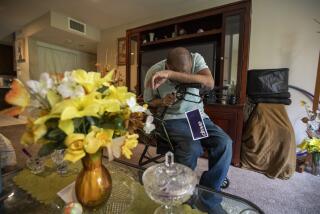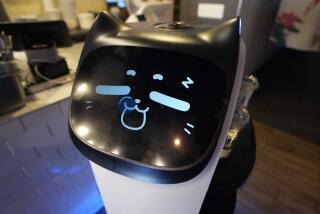The Wait Watcher : Sick of Life in the Slow Lane? Take a Queue From an Expert Whose Line Is Saving Time
- Share via
In Southern California, they seem to be everywhere--at the post office, the market, the Department of Motor Vehicles, the automatic teller machine, the Saturday night movies. And standing in them leaves us plenty of time to ponder the Big Question: If this is life in the fast lane, why do we spend so much of it waiting in snail’s-pace, teeth-grinding lines?
Wait in a line just 15 minutes a day, every day, and by year’s end you’ve kissed 91.25 hours (almost four days) goodby. No wonder 15% of respondents in a recent Los Angeles Times quality-of-life poll cited waiting in line as a pet peeve (and no respondents mentioned a love of lines). Hating lines is natural for most people, says Richard C. Larson, a professor of electrical engineering at the Massachusetts Institute of Technology and self-described “wait watcher” who has spent much of his operations research career studying queues.
Besides wasting time, lines can be socially unjust. People sneak in; sometimes those in adjacent lines who arrive after you are served before you. “Control freaks” may have extraordinary difficulty dealing with lines, Larson observes. They may believe, for example, that the person on the other side of the fast-food counter shouldn’t have the power to decide how quickly they’ll get lunch.
“The aggravation can add up,” says Larson, who was in town last week to speak at a seminar at Rand Corp., a Santa Monica private, nonprofit research group. “Lines can ruin your whole day.”
Dismal as it all may sound, there’s light at the end of the line. Or at least at the end of some. The good news about lines?
--Some are getting shorter.
--A certain type of line is used increasingly because it minimizes social injustices.
--Businesses are trying to take the agony out of lines by providing diversions, offering estimates of the anticipated wait or enticements such as free goods if the wait grows too long.
--Consumers can learn to make the best of even the worst lines.
Lines aren’t getting shorter all by themselves, of course. Increasing numbers of firms, trying to shed their reputation as “time bandits,” are analyzing their lines to try to shorten them and to retain customers who feel they can’t wait.
The analysis depends on “queuing,” a mathematical discipline that uses complicated probability theory to obtain practical information such as how many people might arrive at a bank’s automated teller machine during a weekday lunch hour.
Queuing theory originated in the early 1900s, when a Danish telephone engineer devised a mathematical approach to help design phone switches. Queuing, once the domain of the communications and computer design industries, is slowly spreading into other fields as well.
To help a bank reduce its automatic teller machine lines, for example, Larson and his students observe the sites and watch videotapes to analyze factors such as the mean wait in line, mean time spent in the entire system and the lapse between transactions.
He accounts for how many customers balk (don’t join the line at all) or renege (join the line but drop out in exasperation). Recently, he created a set of equations that allow interpretation of queues without direct observation.
Drawing on all this data, he then advises the bank on how many ATMs are needed and at which locations.
Psychology of Queueing
But this analysis isn’t all. “The queue environment is important,” says Larson, who believes he is one of few researchers to consider not only the mathematical aspects of lines but psychological reactions to them, too.
The type of line a business uses, for example, can mean the difference between customers waiting patiently or stomping off, Larson says.
In his studies, he finds that customers prefer single or “serpentine” lines over multiple lines, the kind often found at fast-food restaurants, where customers line up to order from many servers but aren’t necessarily served on a first-come, first-served basis.
Single lines increasingly are used by airlines, banks and other businesses, he says, noting that customers prefer them because their first-in, first-out policy makes what he calls “slips” and “skips” nearly impossible, unlike what often happens in multiple lines.
“If you’re waiting in line, and somebody joins (another line) after you and gets served before you, from your point of view you’ve been victimized and they have slipped by you,” he explains. “From his or her point of view, they’ve incurred a momentary benefit and they’re skipped over you.”
Larson’s laws on slips and skips: “For every slip there’s a skip.” Slips cost companies more than skips, because customers tend to remember slips but not skips.
A Personal Interest
That is so even for consumer Larson, whose interest in queues was heightened five years ago by his own slip experience. He stood patiently at the window of a major department store, waiting for a clerk to fetch the bike he bought for his son Erik, now 9.
“I had to wait about a half hour for the bike to be delivered from the stockroom,” he said. “Meanwhile, it seemed like 20 people came and gave their inventory receipts to the clerk and got their waffle irons and coffee makers. They came 10 or 15 minutes after me and then left with their goods. I was still there waiting. As exasperating as the 30-minute delay was, what was infuriating was the social injustice.”
The store, he later learned, ran on a “shortest service time first” principle. Translation: Waffle irons and coffee makers simply were easier than a bicycle to grab in the stockroom.
But for Larson, like many others who have been slipped, the experience meant that he made a lifetime pledge never to return to that store.
The accordion queue, another type of line, has been gaining in popularity, especially at Southern California grocery stores.
Accordion queues run on the principle of adding servers as customer congestion increases, then subtracting them as it eases. But like multiple lines, accordion queues can be unfair; when a new line opens and customers dash to it, those waiting the longest aren’t necessarily served most quickly.
But people waiting in lines want more than social justice, Larson finds.
For one thing, they want the time to seem to pass as quickly as possible. To that end, queue diversions have increased in recent years, with more businesses following the lead of a New York bank that began lunch entertainment, sometimes including jazz music and clowns. “One day, unknown to the manager, there was a guy outside selling tickets to get in,” Larson recalls. “Now that suggests they’ve changed a negative experience into a positive one.”
The Human Touch
Some diversions, like playing television or radio news reports, can make people feel they’re making productive use of a wait by keeping abreast of current events. Other diversions, like a restaurant hostess who walks down a line to hand out appetizers or balloons, employ a human touch.
Still other businesses warn the customers about delays. In wait-watchers’ jargon, that practice is “queue delay feedback.” At a New York bank, for example, it means employing an electric eye to count the number of arriving and departing customers in line and displaying the anticipated wait. This system is based on the same principle, albeit more technologically advanced, as Disneyland signs telling park visitors how long it might take to board attractions.
Some businesses also entice customers to put up with lines or waits in exchange for promises of free goods or services. The coffee shop in Larson’s hotel, much to his delight, prominently displayed a sign at the entrance.: “Your lunch in 10 minutes or we’ll dessert you,” meaning that during weekday lunches, customers who don’t have food in front of them 10 minutes after ordering get a free piece of pie.
“Look at that!” Larson exclaims. “A queue delay guarantee!”
The promotional technique, says Tom Wirt, vice president of marketing services for Bakers Square Restaurants, which recently introduced the plan in all 84 of its California restaurants, seeks to “convey the message that you can get in and out quickly.”
That is the word many businesses hope to spread. Last year, Chemical Bank in New York, for example, introduced its “5-4-7” program in 25 of its busiest Manhattan branches, says spokesman Ken Herz. Customers standing in a teller line longer than seven minutes get $5. “We’re giving out less than one claim per branch per week,” Herz says, “and it’s on the honor system. But we believe we’ve improved the quality of our service very dramatically.”
Rather than offer money or free pie, other companies simply promise to try harder to reduce the wait, Larson observes. “There’s lots of emphasis on avoiding queues and waits these days.”
He found three examples at his fingertips: the hotel’s no-wait check-out; the rental car company’s express check-in; and the airline pre-boarding pass.
No matter what improvements do occur, beastly lines sometimes still are simply unavoidable. There’s no telling, for example, when you’ll end up behind the indecisive customer who plods through a fast-food order for 17 teen-agers.
To prepare for such worst cases, Larson suggests, “Bring your life to the queue.” He always carries a mini tape recorder, taking advantage of a line to enter his observations. Some of it might be useful, he reasons, for his coming book, “Our Lives on the Line,” which he will write with his wife, M. Elizabeth Murray, who is trained as a social worker.
Those impatient with the wait also might take a lesson from retirees, who tell Larson they sometimes view lines as an opportune place to socialize.
And one last tip from the queue master: Once you leave the country, all bets are off on techniques for conquering lines. With the exception of international airports, he notes, first-come, first-served is not a universal queue concept. In certain regions, he says, queue etiquette is best described as “survival of the fittest.”
QUEUE TIPS People who talk and write about lines don’t always seem to speak English. Here is sampling of their vocabulary:
Serpentine queues: Single-file lines.
Multiple queues: Several single-file lines for related goods and services from many servers.
Accordion queues: Lines served by increasing numbers of servers as they get longer, and decreasing numbers of servers as they get shorter.
FIFO: First in-first out.
SIRO: Service in random order.
Queue delay guarantee: The promise of free goods or services if there is a long wait in line.
Queue delay feedback: Information about the length of the wait in line, given verbally or by printed or electronic signs.
Balking: Deciding not to join a line, often because it is too long.
Reneging: Leaving a line before getting goods and services. Source: Richard Larson
More to Read
Inside the business of entertainment
The Wide Shot brings you news, analysis and insights on everything from streaming wars to production — and what it all means for the future.
You may occasionally receive promotional content from the Los Angeles Times.










